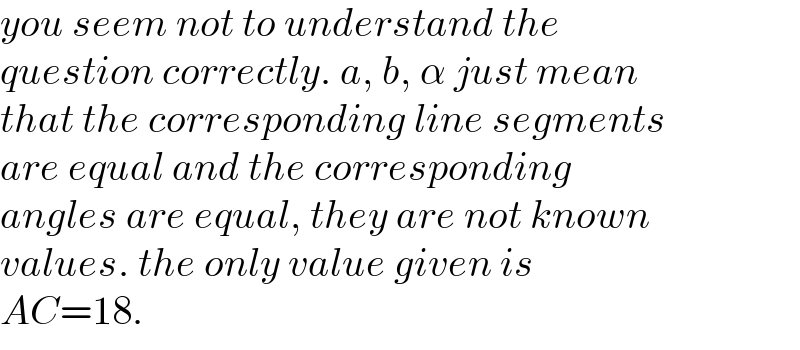
Question Number 187557 by Rupesh123 last updated on 18/Feb/23

Answered by HeferH last updated on 19/Feb/23

Commented by HeferH last updated on 19/Feb/23

$${C}\:{is}\:{centroid}. \\ $$$${CE}\:=\:\mathrm{9}\: \\ $$$$\frac{{BA}}{\mathrm{2}{a}}\:=\:\frac{\mathrm{18}}{\mathrm{27}} \\ $$$$\:{BA}\:=\:\frac{\mathrm{4}{a}}{\mathrm{3}};\:{DB}\:=\:\mathrm{2}{a}\:−\:\frac{\mathrm{4}{a}}{\mathrm{3}}=\:\frac{\mathrm{2}{a}}{\mathrm{3}} \\ $$$$\frac{{x}}{{b}}\:=\:\frac{\frac{\mathrm{4}{a}}{\mathrm{3}}}{\mathrm{2}{a}};\:\:{x}\:=\:\frac{\mathrm{2}{b}}{\mathrm{3}} \\ $$$$\frac{{DE}}{{DB}\:}\:=\:\frac{{EA}}{{BA}}\: \\ $$$$\:{b}\centerdot\frac{\mathrm{3}}{\mathrm{2}{a}}\:=\:\mathrm{27}\centerdot\:\frac{\mathrm{3}}{\mathrm{4}{a}}\:;\:\:{b}\:=\:\frac{\mathrm{27}}{\mathrm{2}} \\ $$$$\:{x}\:=\:\frac{\mathrm{2}}{\mathrm{3}}\centerdot\frac{\mathrm{27}}{\mathrm{2}}\:=\:\mathrm{9}\: \\ $$
Answered by a.lgnaoui last updated on 19/Feb/23
![△ABC et △ADE semblables ((AB)/(AD))=((AC)/(AE))=((BC)/(DE)) 1•((AB)/(AD))=((BC)/(DE)) ⇒AB=((BC×AD)/(DE)) AB=((2a)/b)BC △ACB BC∣∣DE ⇒∡DEC=∡BCA=2α AB^2 =AC^2 +BC^2 −2AC×BCcos 2α ((4a^2 )/b^2 )BC^2 =18^2 +BC^2 −36BCcos 2α (((4a^2 −b^2 )/b^2 ))BC^2 +36cos 2α)BC−18^2 =0 BC^2 +((b^2 ×36cos 2α))/(4a^2 −b^2 ))BC−((18^2 b^2 )/(4a^2 −b^2 ))=0 (BC+((18b^2 cos 2α)/(4a^2 −b^2 )))^2 −(((18^2 b^4 cos^2 2α+18^2 b^2 (4a^2 −b^2 ))/((4a^2 −b^2 )^2 )) =0 (BC+((18b^2 cos 2α)/(4a^2 −b^2 )))^2 −[((18^2 ×b^4 (4a^2 −sin^2 2α))/((4a^2 −b^2 )^2 ))]=0 BC+((18b^2 cos 2α)/(4a^2 −b^2 )) ±((18b^2 (√(4a^2 −sin^2 2α )))/(4a^2 −b^2 )) { ((BC=[((18b^2 )/(4a^2 −b^2 ))(cos 2α+(√(4a^2 −sin ^2 2α)) )])),((BC=[((18b^2 )/(4a^2 −b^2 ))(cos 2α−(√(4a^2 −sin ^2 2α)))])) :}](Q187582.png)
$$\bigtriangleup{ABC}\:\:\:{et}\:\bigtriangleup{ADE}\:{semblables} \\ $$$$\frac{{AB}}{{AD}}=\frac{{AC}}{{AE}}=\frac{{BC}}{{DE}} \\ $$$$\mathrm{1}\bullet\frac{{AB}}{{AD}}=\frac{{BC}}{{DE}}\:\:\:\:\:\Rightarrow{AB}=\frac{{BC}×{AD}}{{DE}} \\ $$$$\:\:\:\:\:\:\:\:\:\:\:\:\:\:\:{AB}=\frac{\mathrm{2}{a}}{{b}}{BC} \\ $$$$\bigtriangleup{ACB}\:\:\:\:{BC}\mid\mid{DE}\:\:\Rightarrow\measuredangle{DEC}=\measuredangle{BCA}=\mathrm{2}\alpha \\ $$$$ \\ $$$$\:{AB}^{\mathrm{2}} ={AC}^{\mathrm{2}} +{BC}^{\mathrm{2}} −\mathrm{2}{AC}×{BC}\mathrm{cos}\:\mathrm{2}\alpha \\ $$$$\frac{\mathrm{4}{a}^{\mathrm{2}} }{{b}^{\mathrm{2}} }{BC}^{\mathrm{2}} =\mathrm{18}^{\mathrm{2}} +{BC}^{\mathrm{2}} −\mathrm{36}{BC}\mathrm{cos}\:\mathrm{2}\alpha \\ $$$$ \\ $$$$\left.\left(\frac{\mathrm{4}{a}^{\mathrm{2}} −{b}^{\mathrm{2}} }{{b}^{\mathrm{2}} }\right){BC}^{\mathrm{2}} +\mathrm{36cos}\:\mathrm{2}\alpha\right){BC}−\mathrm{18}^{\mathrm{2}} =\mathrm{0} \\ $$$${BC}^{\mathrm{2}} +\frac{\left.{b}^{\mathrm{2}} ×\mathrm{36cos}\:\mathrm{2}\alpha\right)}{\mathrm{4}{a}^{\mathrm{2}} −{b}^{\mathrm{2}} }{BC}−\frac{\mathrm{18}^{\mathrm{2}} {b}^{\mathrm{2}} }{\mathrm{4}{a}^{\mathrm{2}} −{b}^{\mathrm{2}} }=\mathrm{0} \\ $$$$\left({BC}+\frac{\mathrm{18}{b}^{\mathrm{2}} \mathrm{cos}\:\mathrm{2}\alpha}{\mathrm{4}{a}^{\mathrm{2}} −{b}^{\mathrm{2}} }\right)^{\mathrm{2}} −\left(\frac{\mathrm{18}^{\mathrm{2}} {b}^{\mathrm{4}} \mathrm{cos}\:^{\mathrm{2}} \mathrm{2}\alpha+\mathrm{18}^{\mathrm{2}} {b}^{\mathrm{2}} \left(\mathrm{4}{a}^{\mathrm{2}} −{b}^{\mathrm{2}} \right)}{\left(\mathrm{4}{a}^{\mathrm{2}} −{b}^{\mathrm{2}} \right)^{\mathrm{2}} }\:\:\:\:=\mathrm{0}\right. \\ $$$$\left({BC}+\frac{\mathrm{18}{b}^{\mathrm{2}} \mathrm{cos}\:\mathrm{2}\alpha}{\mathrm{4}{a}^{\mathrm{2}} −{b}^{\mathrm{2}} }\right)^{\mathrm{2}} −\left[\frac{\mathrm{18}^{\mathrm{2}} ×{b}^{\mathrm{4}} \left(\mathrm{4}{a}^{\mathrm{2}} −\mathrm{sin}\:^{\mathrm{2}} \mathrm{2}\alpha\right)}{\left(\mathrm{4}{a}^{\mathrm{2}} −{b}^{\mathrm{2}} \right)^{\mathrm{2}} }\right]=\mathrm{0} \\ $$$$ \\ $$$${BC}+\frac{\mathrm{18}{b}^{\mathrm{2}} \mathrm{cos}\:\mathrm{2}\alpha}{\mathrm{4}{a}^{\mathrm{2}} −{b}^{\mathrm{2}} }\:\:\pm\frac{\mathrm{18}{b}^{\mathrm{2}} \sqrt{\mathrm{4}{a}^{\mathrm{2}} −\mathrm{sin}^{\mathrm{2}} \mathrm{2}\alpha\:}}{\mathrm{4}{a}^{\mathrm{2}} −{b}^{\mathrm{2}} } \\ $$$$ \\ $$$$\begin{cases}{{BC}=\left[\frac{\mathrm{18}{b}^{\mathrm{2}} }{\mathrm{4}{a}^{\mathrm{2}} −{b}^{\mathrm{2}} }\left(\mathrm{cos}\:\mathrm{2}\alpha+\sqrt{\mathrm{4}{a}^{\mathrm{2}} −\mathrm{sin}\:\:^{\mathrm{2}} \mathrm{2}\alpha}\:\right)\right]}\\{{BC}=\left[\frac{\mathrm{18}{b}^{\mathrm{2}} }{\mathrm{4}{a}^{\mathrm{2}} −{b}^{\mathrm{2}} }\left(\mathrm{cos}\:\mathrm{2}\alpha−\sqrt{\mathrm{4}{a}^{\mathrm{2}} −\mathrm{sin}\:\:^{\mathrm{2}} \mathrm{2}\alpha}\right)\right]}\end{cases}\: \\ $$
Commented by mr W last updated on 19/Feb/23

$${you}\:{seem}\:{not}\:{to}\:{understand}\:{the} \\ $$$${question}\:{correctly}.\:{a},\:{b},\:\alpha\:{just}\:{mean}\: \\ $$$${that}\:{the}\:{corresponding}\:{line}\:{segments} \\ $$$${are}\:{equal}\:{and}\:{the}\:{corresponding} \\ $$$${angles}\:{are}\:{equal},\:{they}\:{are}\:{not}\:{known} \\ $$$${values}.\:{the}\:{only}\:{value}\:{given}\:{is}\: \\ $$$${AC}=\mathrm{18}. \\ $$
Commented by a.lgnaoui last updated on 19/Feb/23

$${but}\:{this}\:{formula}\:{gets}\:{any}\:{valuee} \\ $$$${for}\:{BC}\:{correspond}\:{to}\:\:\boldsymbol{{a}},\:\boldsymbol{{b}},\:{and}\:\boldsymbol{\alpha} \\ $$$${with}\:\:{equal}\:{terme}\:\frac{\mathrm{18}{b}^{\mathrm{2}} }{\mathrm{4}{a}^{\mathrm{2}} −{b}^{\mathrm{2}} }\left(\mathrm{cos}\:\mathrm{2}\alpha\pm\sqrt{\left(\mathrm{4}{a}^{\mathrm{2}} −\mathrm{sin}^{\mathrm{2}} \mathrm{2}\alpha\right)\:}\right. \\ $$$$ \\ $$
Commented by mr W last updated on 19/Feb/23

$${but}\:{a},{b}\:{and}\:\alpha\:{can}\:{not}\:{be}\:{any}\:{values}!\: \\ $$$${they}\:{are}\:{not}\:{independent}.\:\:{they}\:{have} \\ $$$${actually}\:{fixed}\:{values}\:{through}\:{the} \\ $$$${value}\:{of}\:{AC}=\mathrm{18}. \\ $$
Answered by ajfour last updated on 19/Feb/23

Commented by ajfour last updated on 19/Feb/23

$$\mathrm{2}{s}=\mathrm{18} \\ $$$$\mathrm{3}{s}=\mathrm{27} \\ $$$$\frac{\mathrm{3}{s}}{{b}}=\frac{{a}+{p}}{{a}−{p}}=\frac{\mathrm{2}}{\mathrm{1}}\:\:\:\:...\left({i}\right) \\ $$$$\Rightarrow{b}=\frac{\mathrm{3}{s}}{\mathrm{2}}=\frac{\mathrm{27}}{\mathrm{2}}\:\:\:\:\:\&\:\:\:\:\:\frac{{p}}{{a}}=\frac{\mathrm{2}−\mathrm{1}}{\mathrm{2}+\mathrm{1}}=\frac{\mathrm{1}}{\mathrm{3}} \\ $$$$\:\:\frac{{x}}{{b}}=\frac{{a}+{p}}{\mathrm{2}{a}}\: \\ $$$$\Rightarrow\:\:{x}=\frac{{b}}{\mathrm{2}}\left(\mathrm{1}+\frac{{p}}{{a}}\right)=\frac{\mathrm{27}}{\mathrm{4}}\left(\frac{\mathrm{4}}{\mathrm{3}}\right) \\ $$$$\:\:\:\:\:{x}=\mathrm{9} \\ $$
